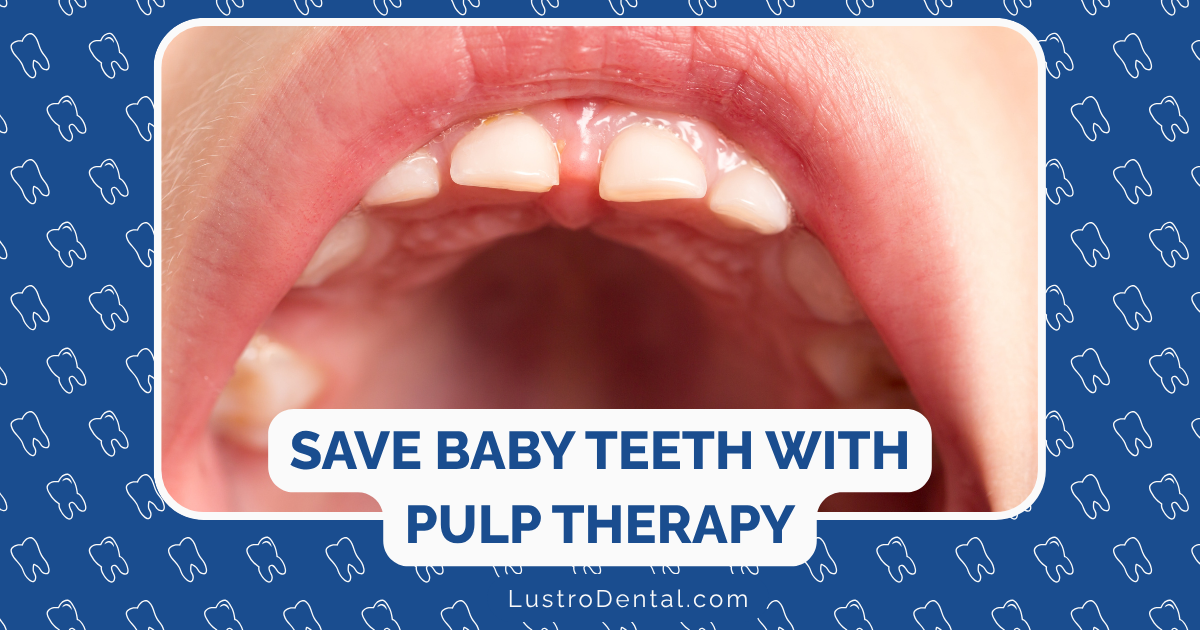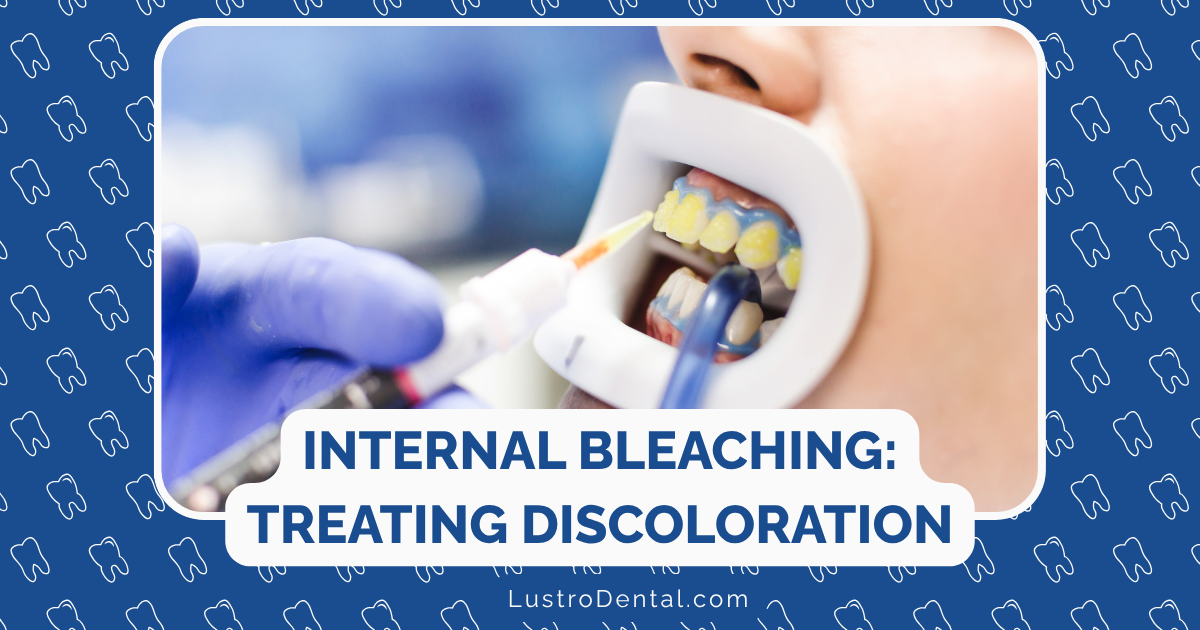Saving Baby Teeth: When Pulp Therapy Is the Right Choice

“But they’re just baby teeth—don’t they fall out anyway?”
As a dental health advocate, I hear this question often from well-meaning parents. And while it’s true that primary (baby) teeth will eventually be replaced by permanent teeth, the idea that they’re somehow disposable couldn’t be further from the truth.
Primary teeth play crucial roles in your child’s development: they help with proper speech, enable effective chewing, maintain space for permanent teeth, and contribute to facial aesthetics and self-confidence. Losing them too early can lead to a cascade of issues that might affect your child for years to come.
That’s why, when a baby tooth suffers from deep decay or trauma that reaches the dental pulp (the living tissue inside the tooth), modern pediatric dentistry focuses on preservation rather than extraction whenever possible. The key to save baby teeth? Pulp therapy.
Understanding the Dental Pulp in Primary Teeth
Before we dive into treatment options, let’s understand what we’re trying to save.
The dental pulp is the soft tissue at the center of each tooth, containing blood vessels, nerves, and connective tissue. It’s essentially the living heart of the tooth, responsible for:
- Providing sensation (including pain, which serves as a warning system)
- Delivering nutrients to the tooth
- Producing dentin, the layer beneath the enamel
- Fighting infections through immune responses
In children’s teeth, the pulp is proportionally larger than in adult teeth, with pulp horns (extensions of the pulp) that reach closer to the tooth surface. This means decay can reach the pulp more quickly in primary teeth, often before parents notice any symptoms.
Signs Your Child Might Need Pulp Therapy
Children aren’t always able to articulate dental pain clearly, so it’s important to watch for these indicators:
- Unprovoked toothache or pain that wakes them at night
- Sensitivity to hot or cold that lingers after the stimulus is removed
- Pain when chewing or biting
- Swelling or redness in the gums around a specific tooth
- A pimple-like bump on the gum (called a fistula)
- Darkening or discoloration of a tooth
- Facial swelling in the area of a painful tooth
If you notice any of these signs, it’s important to see a pediatric dentist promptly. Early intervention often means simpler, less invasive treatment.
Types of Pulp Therapy for Primary Teeth
According to the American Academy of Pediatric Dentistry, there are several approaches to treating pulp issues in baby teeth, depending on the extent of the damage:
1. Indirect Pulp Treatment (IPT)
When it’s used: For deep cavities approaching the pulp, but without actual pulp exposure or symptoms of irreversible pulpitis (severe inflammation).
What happens: The dentist removes most of the decay but leaves a thin layer of affected dentin to avoid exposing the pulp. This area is then covered with a biocompatible material that promotes healing and prevents bacterial invasion.
Success rate: Recent systematic reviews show that IPT has an excellent success rate of over 90% at 24 months, making it the preferred choice when appropriate.
Materials used: Traditionally, calcium hydroxide was used, but newer materials like glass ionomer cement (GIC) and Biodentine have shown excellent results.
Dr. Maria Chen, a pediatric dentist at Children’s Dental Health Center, explains: “Indirect pulp treatment is often our first choice when we can preserve the vitality of the pulp. It’s minimally invasive and has excellent outcomes when case selection is appropriate.”
2. Direct Pulp Capping
When it’s used: When there’s a tiny exposure of the pulp in an otherwise healthy tooth, typically due to trauma rather than decay.
What happens: The exposed pulp is covered directly with a biocompatible material to promote healing and dentin bridge formation.
Success rate: In primary teeth, direct pulp capping has historically shown lower success rates than in permanent teeth, but newer materials are improving outcomes.
Materials used: Mineral Trioxide Aggregate (MTA) and Biodentine have largely replaced calcium hydroxide for this procedure due to their superior biocompatibility and sealing ability.
It’s worth noting that direct pulp capping in primary teeth due to carious exposure (rather than traumatic exposure) is generally not recommended due to lower success rates compared to pulpotomy.
3. Pulpotomy (“Baby Root Canal”)
When it’s used: When decay or trauma has exposed the pulp, but the infection is limited to the crown portion of the tooth, with the root pulp remaining healthy.
What happens: The dentist removes the infected coronal (top) portion of the pulp while leaving the healthy root pulp intact. The remaining pulp is treated with a medicament to promote healing, then sealed with a restoration.
Success rate: With modern materials like MTA or Biodentine, success rates exceed 90% at 24 months.
Materials used: While formocresol was traditionally used, calcium silicate cements like MTA and Biodentine are now strongly recommended by the latest research due to their excellent biocompatibility and high success rates.
4. Pulpectomy (Complete Pulp Removal)
When it’s used: When the entire pulp, including the root portion, is irreversibly infected or necrotic (dead).
What happens: Similar to a traditional root canal in adults, the entire pulp is removed from both the crown and roots. The canals are cleaned, shaped, and filled with a resorbable material that will disappear as the primary tooth’s roots naturally resorb before exfoliation.
Success rate: Success rates range from 70-90%, depending on the extent of infection and the restorability of the tooth.
Materials used: Zinc oxide eugenol, iodoform-based pastes (like Metapex or Vitapex), or a combination material like Endoflas are commonly used as filling materials.
The Latest Advancements in Pulp Therapy
Pediatric pulp therapy has seen significant advancements in recent years, making treatments more effective, biocompatible, and comfortable for children:
Bioactive Materials
Calcium silicate-based materials like MTA and Biodentine have revolutionized pulp therapy. These materials:
- Actively promote healing and dentin formation
- Provide an excellent bacterial seal
- Are highly biocompatible
- Result in better long-term outcomes
According to a 2024 systematic review, pulpotomies performed with calcium silicate cements showed significantly better outcomes than those using traditional materials like formocresol or ferric sulfate.
Minimally Invasive Approaches
The trend toward tissue preservation has led to more conservative approaches:
- Selective caries removal preserves more tooth structure and reduces the risk of pulp exposure
- The Hall Technique places stainless steel crowns over decayed teeth without removing caries, sealing them off from the oral environment
- Silver Diamine Fluoride (SDF) can arrest decay progression in some cases, potentially avoiding the need for invasive procedures
Dr. James Wilson, researcher at Pediatric Dental Innovations, notes: “Our approach has shifted dramatically toward preservation rather than replacement. With modern materials and techniques, we can save teeth that would have been extracted just a decade ago.”
Why Save Baby Teeth? The Long-Term Benefits
Parents sometimes wonder if these procedures are worth it when the tooth will eventually fall out anyway. Here’s why preserving primary teeth matters:
1. Space Maintenance
Primary teeth hold space for permanent teeth. Losing them too early can lead to:
- Shifting of adjacent teeth
- Loss of arch length
- Impaction of permanent teeth
- Need for orthodontic intervention later
2. Speech Development
Many primary teeth remain until ages 10-12, during critical speech development years. Missing front teeth can affect pronunciation of certain sounds, potentially leading to speech issues.
3. Proper Nutrition
Effective chewing is important for nutrition and digestive health. Missing teeth can limit food choices or lead to inadequate chewing.
4. Self-Esteem and Social Development
Visible missing teeth can affect a child’s self-confidence, potentially impacting social interactions during formative years.
5. Avoiding Trauma of Extraction
Preserving a tooth through pulp therapy is generally less traumatic than extraction, helping maintain a positive attitude toward dental care.
What to Expect: The Pulp Therapy Experience
If your child needs pulp therapy, here’s what you can typically expect:
Before the Procedure
- Diagnosis: The dentist will take X-rays and perform tests to determine the extent of pulp involvement.
- Treatment planning: The appropriate procedure will be selected based on the specific case.
- Preparation: The dentist will explain the procedure in child-friendly terms and answer any questions.
During the Procedure
- Anesthesia: Local anesthesia will ensure your child is comfortable throughout the procedure. For anxious children, additional sedation options may be discussed.
- Isolation: A rubber dam may be placed to keep the area clean and dry.
- Treatment: The selected procedure will be performed, typically taking 30-60 minutes.
- Restoration: After pulp treatment, the tooth usually receives a crown to protect it from fracture and provide a good seal.
After the Procedure
- Recovery: Most children return to normal activities the same day, with minimal discomfort managed with over-the-counter pain relievers if needed.
- Follow-up: Regular check-ups will monitor the treated tooth and ensure it’s healing properly.
- Long-term care: Maintaining good oral hygiene and regular dental visits are essential for the success of pulp therapy.
Real Stories: Successful Pulp Therapy Cases
Eight-year-old Emma came to our office with a severely decayed lower primary molar. Her mother was concerned about the pain Emma was experiencing but hesitant about extensive treatment for a “tooth that would fall out anyway.”
After discussing the importance of the tooth for proper development and the options available, Emma’s mother agreed to a pulpotomy with MTA, followed by a stainless steel crown. Two years later, the tooth is still functioning perfectly, maintaining space for the permanent tooth that will eventually replace it. Emma’s mother later shared that the treatment helped her daughter return to normal eating and eliminated the pain that had been affecting her sleep and school performance.
Stories like Emma’s are common in pediatric dental practices, where modern pulp therapy techniques are saving thousands of primary teeth each year.
Making the Decision: Is Pulp Therapy Right for Your Child?
When considering treatment options for your child’s damaged primary tooth, discuss these factors with your dentist:
- Extent of damage: How much of the pulp is affected?
- Symptoms: Is your child experiencing pain or signs of infection?
- Time until natural exfoliation: How long until the tooth would naturally fall out?
- Strategic importance: Is it a key tooth for development or function?
- Child’s cooperation: Can your child tolerate the procedure?
- Cost considerations: What are the financial implications, including insurance coverage?
Remember that each child and situation is unique. A pediatric dentist can help you weigh these factors to make the best decision for your child’s specific needs.
Finding the Right Provider
Pulp therapy for primary teeth requires specialized knowledge and skills. Consider these factors when seeking treatment:
- Pediatric dental specialists have additional training specifically focused on treating children.
- Experience matters – look for providers who routinely perform pulp therapy procedures.
- Child-friendly environment can make the experience less stressful for your child.
- Communication style is important – the provider should explain options clearly and answer questions thoroughly.
Many dental schools and community health centers also offer pediatric dental services at reduced rates if cost is a concern.
Conclusion: A Worthwhile Investment in Your Child’s Health
While it might seem easier to simply extract a problematic primary tooth, the long-term consequences of premature tooth loss often outweigh the short-term convenience. Modern pulp therapy techniques offer safe, effective ways to preserve these important teeth until they’re ready to be naturally replaced by their permanent successors.
By understanding the options available and working with a skilled pediatric dental provider, you can make informed decisions that support your child’s oral health, development, and well-being for years to come.
Remember: Those little teeth have big jobs to do—and they’re worth saving.
Have questions about pulp therapy for primary teeth? Share them in the comments below, and we’ll address them in a future post!







